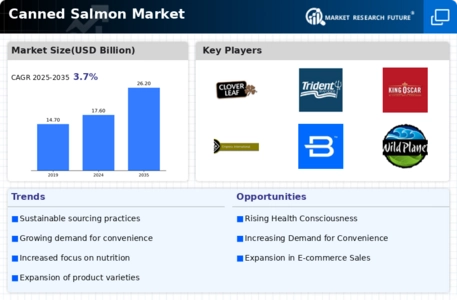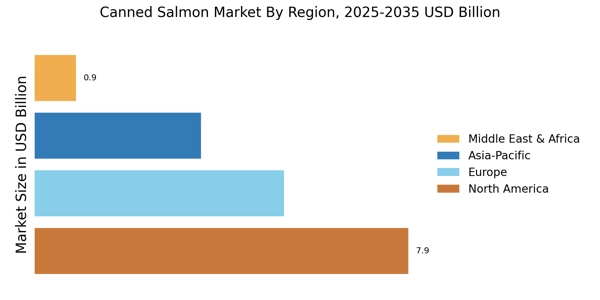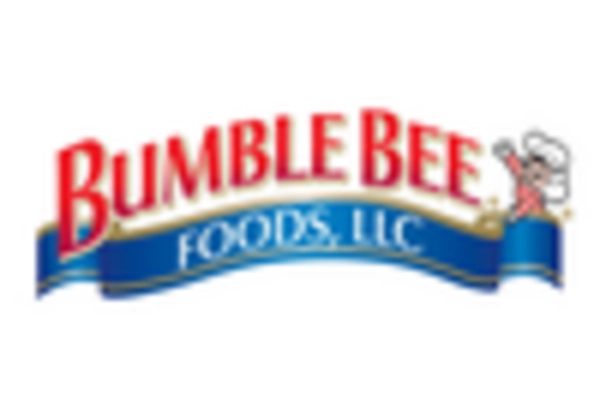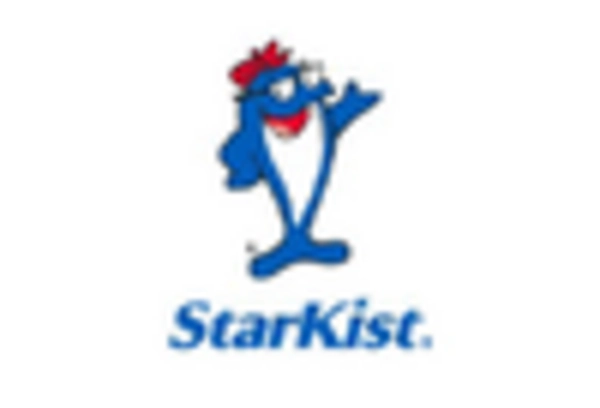Innovative Product Variants
Innovation within the Canned Salmon Market is driving consumer interest and expanding market opportunities. Manufacturers are introducing a variety of product variants, including flavored and seasoned options, to cater to diverse consumer preferences. This diversification not only enhances the appeal of canned salmon but also attracts new customer segments. Recent data indicates that flavored canned salmon products have seen a 25% increase in sales over the past year, suggesting a strong consumer appetite for innovation. As companies continue to explore new flavors and packaging formats, the Canned Salmon Market is likely to experience sustained growth, driven by the desire for unique and exciting culinary experiences.
Health Benefits of Canned Salmon
The rising awareness of health benefits associated with canned salmon consumption appears to be a pivotal driver in the Canned Salmon Market. Canned salmon is rich in omega-3 fatty acids, which are known to support heart health and cognitive function. As consumers increasingly prioritize nutrition, the demand for canned salmon has surged. According to recent data, the consumption of canned salmon has increased by approximately 15% over the past three years, reflecting a shift towards healthier dietary choices. This trend is likely to continue as more individuals seek convenient yet nutritious food options. The Canned Salmon Market is thus positioned to benefit from this health-conscious consumer behavior, potentially leading to sustained growth in sales and market expansion.
Sustainability and Ethical Sourcing
Sustainability has emerged as a critical concern for consumers, influencing their purchasing decisions in the Canned Salmon Market. The demand for sustainably sourced seafood is on the rise, with consumers increasingly favoring products that are certified by reputable organizations. This shift is indicative of a broader trend towards environmental responsibility, as consumers seek to minimize their ecological footprint. Data suggests that approximately 60% of consumers are willing to pay a premium for sustainably sourced canned salmon. This growing preference for ethical sourcing is likely to drive innovation and competition within the Canned Salmon Market, as companies strive to meet consumer expectations while adhering to sustainable practices.
Convenience and Ready-to-Eat Options
The fast-paced lifestyle of modern consumers has led to a heightened demand for convenience foods, significantly impacting the Canned Salmon Market. Canned salmon offers a ready-to-eat solution that aligns with the needs of busy individuals and families. The ease of preparation and versatility of canned salmon in various dishes make it an attractive option for consumers seeking quick meal solutions. Recent market analysis indicates that the ready-to-eat segment of the canned seafood market has grown by 20% in the last year. This trend suggests that the Canned Salmon Market is well-positioned to capitalize on the increasing preference for convenient food options, potentially leading to enhanced market penetration and growth.
E-commerce Growth and Online Retailing
The rise of e-commerce has transformed the retail landscape, significantly impacting the Canned Salmon Market. Online shopping offers consumers greater convenience and access to a wider range of products, including specialty canned salmon options that may not be available in traditional retail outlets. Recent statistics reveal that online sales of canned seafood have increased by 30% in the past year, highlighting the shift towards digital purchasing. This trend suggests that the Canned Salmon Market must adapt to the evolving retail environment by enhancing online presence and distribution strategies. As more consumers turn to online platforms for their grocery needs, the potential for growth in the canned salmon segment appears promising.


















Leave a Comment